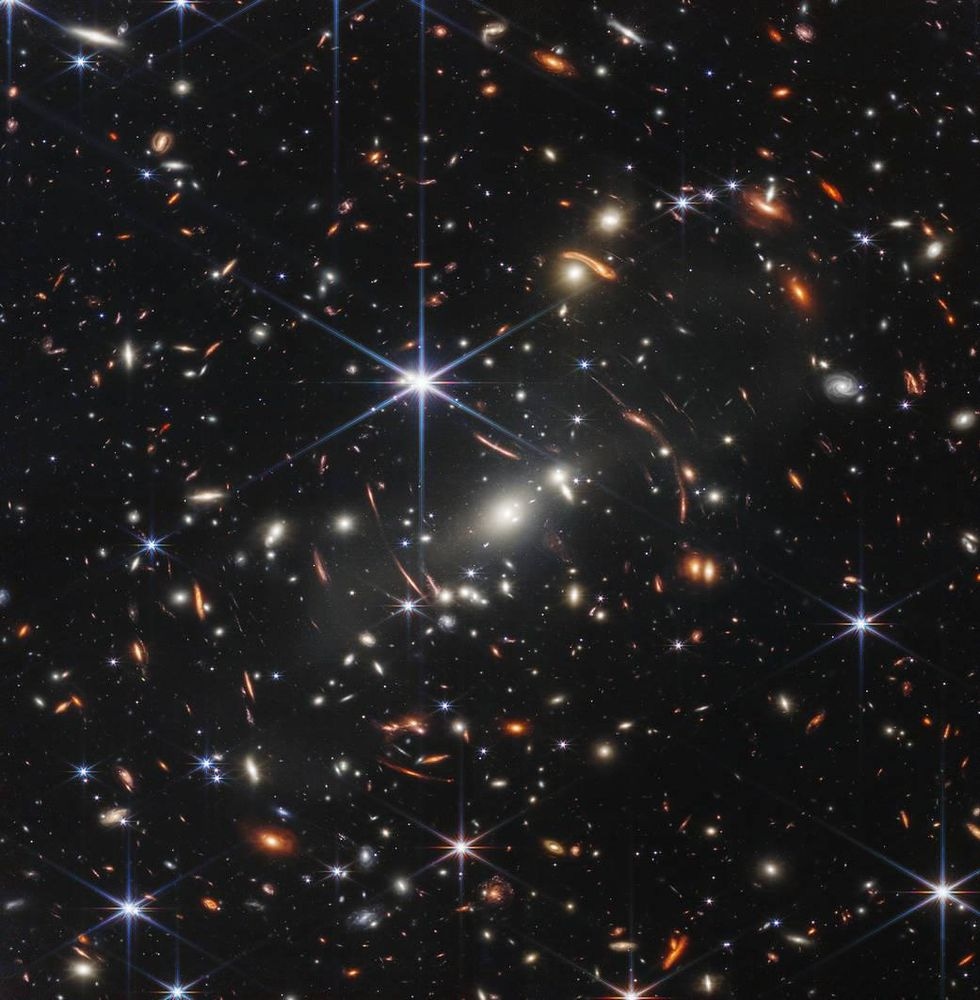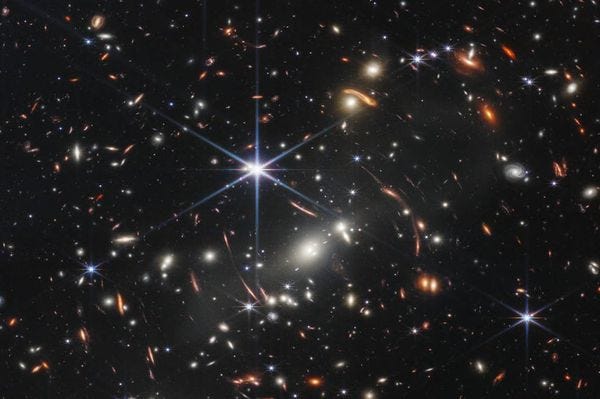Space Probably Thinks It’s REAL F*ckin Hot Right Now
More pictures coming from the Webb space telescope ... NOW!
NASA and the White House yesterday released the first full-color images taken by the James Webb Space Telescope, showing a picture that only took 13 billion years to make (at least for the farthest away pinpoints of light). The image, from Webb's Near-Infrared Camera , shows the "faintest objects ever observed in the infrared," and to give you an idea of how much detail is crammed into just this one image, NASA explains the image "covers a patch of sky approximately the size of a grain of sand held at arm’s length by someone on the ground."
Well, yeah, wow. If you want the really high-resolution versions of the image for your nerd computer background, those can be downloaded from the Webb Telescope website.
The "deep field" image is actually a composite of images at different wavelengths, captured over 12 and a half hours, and as NASA 'splains further,
shows the galaxy cluster SMACS 0723 as it appeared 4.6 billion years ago. The combined mass of this galaxy cluster acts as a gravitational lens , magnifying much more distant galaxies behind it. Webb’s NIRCam has brought those distant galaxies into sharp focus – they have tiny, faint structures that have never been seen before, including star clusters and diffuse features. Researchers will soon begin to learn more about the galaxies’ masses, ages, histories, and compositions, as Webb seeks the earliest galaxies in the universe.
You're seeing through time, and you didn't even have to eat anything spicy!
The $10 billion Webb telescope is a successor to the Hubble Space Telescope we know and love, and able to obtain far more detailed data in the infrared spectrum than Hubble. It's parked out in orbit around the Sun, a million miles from Earth, unlike the Hubble, which orbits our planet. That also means the Webb telescope, launched Christmas 2021 as a present for geeks (fine, and because that was the launch window), can't be repaired if anything goes wrong. But so far, it's unfolded itself and started gathering data just fine. The Washington Post has more on the mission (gift link, no paywall), which faced delays and cost overruns, and was almost cancelled by Congress.
The ambitious scientific goals set out by NASA and its partners required a revolutionary design. The scientists who in the 1980s began advocating what was originally called the Next Generation Space Telescope argued that an infrared space observatory would be able to peer deeper into the universe — and further back in time, to an era roughly a few hundred million years after the big bang. That’s when the first stars ignited and starlight flooded the young universe.
The telescope — or the “observatory,” as scientists often call it — features 18 gold-plated, hexagonal, individually maneuverable mirrors that function like a single mirror about 21 feet across. This giant light bucket is not inside a protective tube but rather is open to the universe like a flower.
The mirrors, cameras and other instruments that need to be kept ultracold for infrared astronomy are protected from the sun’s radiation by a five-layered, tennis-court-sized sun shield. The sun shield and many other components, including the mirrors, were folded up at launch and had to be deployed during the telescope’s nearly month-long journey to its orbital post.
According to one report, there were 344 "single point failure" possibilities that could have scotched the telescope, but none of them happened. ThePost notes that one "micrometeoroid" has hit one of the mirror segments and put it slightly out of alignment, but as CNN explains, Webb was designed to weather such cosmic collisions, and NASA was able to readjust the mirror to mostly reduce the distortion.
This morning at 10: 30 a.m. Eastern, NASA is releasing a whole bunch more images and data from Webb. We've got the YouTube linky for you right here, and the agency will be releasing the images one by one on social media, too. More information about your many viewing options right here.
As of this publishing, the livestream has just begun. But if you want to just instantly tear up at the sound of Carl Sagan's voice, go ahead and watch the teaser trailer that starts the countdown first. I'm an easy mark for a little bit of Sagan.
And here is that livestream:
And here's the full image released by NASA yesterday:

For fun, you can also play around with UC-Santa Cruz's zoomable version, which allows you to magnify parts of the image for a closer look. (It gets pixel-y pretty quick.)
For a sense of how much more detail the Webb observatory can capture compared to the Hubble, science writer Shannon Stirone posted this comparison of a portion of the Webb image, on the right, with an earlier deep field image of the same section of space from Hubble (side-by-side comparison by Doug Chini):
“Hubble vs JWST. The same patch of sky. Just amazing.”
— Shannon (we're already in space) Stirone 💀 (@Shannon (we're already in space) Stirone 💀) 1657582552
At the white House event yesterday, NASA administrator Bill Nelson, the former astronaut and senator from Florida, said
We are going to be able to answer questions that we don’t even know what the questions are yet,” he said. When he added that the technology could determine whether other planets were habitable, Mr. Biden responded with a “Whoa.”
As the ceremony ended and the reporting pool was escorted from the room, Mr. Biden was heard to say, “I wonder what the press are like in those other places.”
Also too, if you want to watch yesterday's news conference unveiling the first image, that's below. And if you decide you want to get all sentimental about how we're all here together on our Pale Blue Dot , that'd be good too.
[ NBC News / NASA / NYT / CNN / WaPo (gift link)]
Yr Wonkette is funded entirely by reader donations. If you can, please give $5 or $10 a month so Dok can keep throwing you all the Sense Of Wonder you can handle.
Do your Amazon shopping through this link, because reasons .





What is this?!??!You godless heathens believe the universe is millions of centuries old and light has a finite velocity and takes years to get from star to star?The earth is flat and round like the top of a table, supported on four pillars, with the sky a thin solid dome above it, and the stars are little glittery lights attached to the inner surface of the dome by God.Genesis Chapter One, it's there in black and white, and ... oh no, I'm beginning to realize that you godless heathens have a picture that's grander and more fascinating than Genesis Chapter One!That's it, I'm damned.Worth it, though.
You left out the turtles (all the way down).